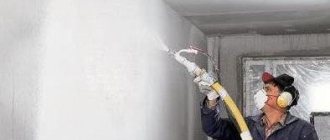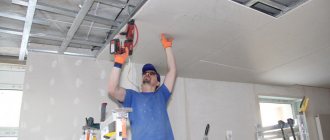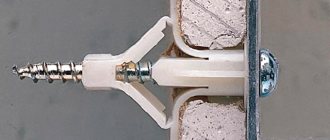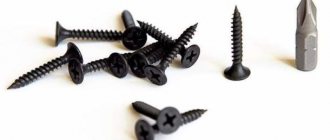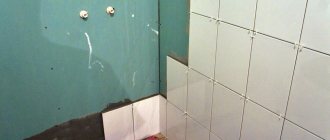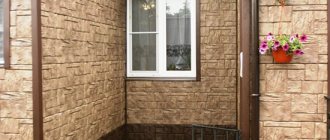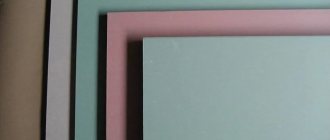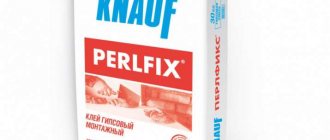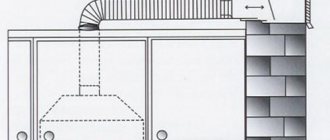Icer
23532 0 5
Icer October 22, 2016Specialization: master in the construction of plasterboard structures, finishing work and laying floor coverings. Installation of door and window units, finishing of facades, installation of electrical, plumbing and heating - I can give detailed advice on all types of work.
Drywall is one of the most popular finishing materials today, so the issue of attaching various elements to it is very relevant. There are a lot of fastening options, and today we will look at one of the most popular solutions – Butterfly drywall fasteners.
In the photo: Butterfly fastening for drywall is simple and reliable
Where and how to use a butterfly dowel
Leveling the walls with plasterboard sheets, as well as constructing partitions and false walls from it during modern renovations will not surprise anyone.
Indeed, it is a simple, practical and effective material that is easy to cut and install. But at the same time, gypsum board is quite fragile in comparison, for example, with bases made of concrete or brick, and when using it you will definitely need a special Butterfly dowel. Using this dowel, you can attach not very heavy household structures to plasterboard sheathing - hangers, wall lamps, shelves, etc., without fear that they will collapse. In this article we will look at the characteristics of the Butterfly dowel, tell you how much weight it can withstand, and also tell you about the features of its installation.
The shape of the Butterfly dowel is simple and unique at the same time
Tips and tricks
If you have never encountered installation and finishing work, then it is best to entrust this task to professionals. They will get the job done quickly, and you won't have to redo anything. And for those who decide to install the fasteners themselves, it is important to know a few basic points that will significantly affect the efficiency and final result of your work.
- Drive the butterfly dowel with a hammer. It is not enough to simply screw in the anchor, as it may dangle in the hole and not be secured tightly enough.
- Maintain optimal sizes. If you make too large a hole in a sheet of drywall, the fasteners will not hold well and will not bring the necessary benefit.
- Watch the thickness of the sheet. The “butterfly” works great on products whose thickness does not exceed five millimeters. For larger structures, you should select a different fastening element. At a minimum it should be longer.
- Leave enough space behind the gypsum board. Remember that there must be at least thirty-five millimeters of free space behind the sheet of drywall. This is the only way you will be able to optimally tighten the anchor by pressing the stop.
- Use a regular screwdriver. Don’t be lazy and put the powerful drill aside. Since high speeds of the equipment can easily damage the plastic edges of the stop. While a screwdriver will not harm them at all.
Operating principle and performance characteristics
The Butterfly dowel has a diamond shape, and its flexibility allows you to easily insert it into a narrow hole drilled in drywall, and then, when clamped with a self-tapping screw, expand the fastening element in another plane.
In the process of screwing the self-tapping screw into the dowel, the latter takes a special shape in the form of a stop spaced across the area on the back side of the plasterboard sheet. It is thanks to the large area of distribution of the load on the drywall that it is possible to increase the load-bearing capacity of plasterboard.
A similar example would be the stability, all other things being equal, of a skier on the snow relative to a person without skis - the latter will fall into deep snow, while skis make it possible to distribute the load over a large area and easily support a person with the same weight.
The butterfly dowel in working position increases the load area on the drywall
Characteristics
Let's look at the main technical characteristics of the Butterfly dowel:
How much weight can the Butterfly dowel in drywall support?
How much weight can a Butterfly dowel in drywall withstand? It's not hard to count. If the working load on it is up to 30 kg, then multiplying the number of fasteners allocated to hold the structure being fixed by the working load indicator, we get the real weight that the dowel will be able to withstand.
For example, a hanging bookshelf with two hinges (that is, with two attachment points), with a maximum load of up to 50 kg, will hang quite securely, even with a margin. At the same time, for a shelf weighing 70 kg it would be better to add another attachment point, otherwise there will be a risk of it tearing off.
Options for self-tapping screws for the Butterfly dowel
Specifications
How to properly attach skirting boards to the ceiling
When choosing dowels for drywall, it is necessary to take into account not only their type, but also their technical characteristics. So on the modern market there are models with diameters (mm):
In this case, the length of the dowel for drywall can be (mm):
The classic version of the dowel must be made taking into account the requirements of the GOST 28457-90 standard and represent a base that is intended for installing a self-tapping screw. Its feature is a high wear resistance coefficient and high joint strength.
Now we will learn how to screw a dowel into drywall.
Technology
Installing a dowel into a sheet of drywall is not a difficult task. If you take a screwdriver as a classic type of dowel, then its installation is done by using a special drill that fits the diameter.
- Depending on which element will be fixed, it may be necessary to prepare the drywall. It will consist of cleaning the surface from various debris and upon completion, a hole can be created.
- If a dowel is used during installation, which does not require pre-drilling, then it is enough to just mark the location of its installation on the drywall.
Read below about the price of butterfly dowels, molly and others for drywall.
Umbrella dowel for drywall
Calculation and price of materials
In order to purchase materials in the required volume, they must be calculated. As for the dowels, this task is performed quite simply.
To get the required number, you will need to multiply the area of all sheets of drywall by 0.7 and then by 2. To be more precise, two screws and, accordingly, the same number of dowels are used for one suspension.
The cost of one fastener will depend on its parameters, material and type. A hollow plastic dowel can be purchased for only 2 rubles per piece, while a “butterfly” will cost 2-3 times more. It is best to buy these elements in large or small wholesale. So one type of metal dowel for drywall will cost you 2,500 rubles per 1,000 units.
Popular manufacturers of this fastener include the following companies:
- TOX, KEW and FISCHER (Germany);
- HILTI (Liechtenstein);
- SORMAT (Finland);
The dowel is actively used when working with drywall, as it is the key to its high-quality and durable fastening.
This video will show you how to attach a butterfly dowel for drywall:
StroyRes.NET is an online magazine about building materials. Here you will find their description and physical and chemical properties. We cover applications with practical lessons, and also cover production, delivery and storage of materials.
Installation of dowel Butterfly
To make holes for a Butterfly dowel, choose a drill with a diameter of 10 mm. Let's look at how to fasten using this dowel:
Installation of the Butterfly dowel is carried out according to the presented diagram
So, we have figured out the characteristics and installation rules of one of the most popular fasteners - the Butterfly dowel. It is easy to install, fairly accessible and capable of carrying a fairly large load.
Choose this particular dowel for mounting small structures on plasterboard; for massive ones, use embedded profiles.
Self-tapping dowel DRIVA - fast and convenient!
Self-tapping dowel - this fastener fully lives up to its name, since its outer surface has a thread for screwing into drywall. Nylon screws, numbered TT22, are screwed into a ready-made hole, but metal fasteners with the international designation DRIVA, in addition to threads, also have a drill at the end, which makes it possible to independently screw them into the surface using a conventional screwdriver or screwdriver. This significantly saves time when dealing with large volumes of work. However, for sheet thicknesses over 15 mm, it is still recommended to drill a hole.
Such a dowel is ideally suited for fastening into single-layer or multi-layer plasterboard with decorative or insulating material on the other side. Thanks to the large number of sizes, the dowel can be selected so that it does not come out on the other side of the partition. DRIVA dowels can also be used for more durable gypsum fiber boards.
What it is
A butterfly dowel nail consists of a self-tapping screw and a plastic part that resembles the wings of a butterfly. The peculiarity of this fastening element is that when twisted, the wings straighten and are pressed against the back of the plasterboard sheet. This allows you to distribute the load, which is a big plus when working with such a fragile material as drywall.
Also, this dowel-nail has special ribbed sections that do not allow it to scroll in the gypsum board. There is also ribbing on the inside of the head that prevents the fastener from folding.
It differs from other dowel nails in the weight it can withstand. Permissible load – up to 20 kg.
The butterfly dowel can be:
The most common type is the plastic dowel. It is cheap to produce and therefore widely available. The advantage of plastic and nylon fasteners is their wear resistance: they do not rust. But it is better not to hang heavy objects on them.
Metal “butterflies” are less common on sale and are more expensive than their analogues, but they can withstand heavy loads. Some manufacturers coat them with special anti-rust agents, which is also a plus.
Fastening method
It is very important to properly secure the structure, no matter what type of work you undertake. There are simple rules that, if followed, will help you secure the butterfly correctly and save you from unnecessary difficulties. To avoid unnecessary problems, it is always better to carefully read the description of the process before starting work. This will allow you to form a clear picture of your actions in your head and prevent you from making mistakes.
Always, before starting work, mark on the plasterboard sheet the place where the future fastening element should be located. Sometimes it happens that the butterfly and the screw are longer than the distance from the plasterboard sheet to the wall. What to do in such cases? Create a hole of sufficient depth in the wall using a drill and screw a self-tapping screw into it. Then the self-tapping screw will go right through the plasterboard sheathing and fit tightly into the wall. Thus, without using materials like nails or special dowels and self-tapping screws of increased length, it is possible to fasten individual elements of not very heavy weight to a plasterboard structure using only a butterfly.
With the help of plastic fasteners - anchors, the butterfly can be an excellent means for attaching clamps to a plasterboard structure. These fasteners can be used to secure small but necessary things. Examples of such things can be paintings, shelves and much more, but such a fastener is not suitable for heavy things. A plastic element simply will not withstand heavy loads, so do not count on a butterfly dowel if you are going to mount something large and massive to a plasterboard structure. In such situations, it is better to consider alternative fasteners made of metal.
Why do you need a butterfly dowel?
Drywall is used to level walls and create decorative structures in the interior. This is a fragile material that cannot withstand heavy loads. Therefore, it is not recommended to hang shelves and cabinets on it. It is allowed to attach only small lamps and paintings to it, but this requires special dowel nails.
The butterfly dowel is also used for fastening to chipboard, plywood, gypsum fiber board, and also for other sheet material up to 12 mm thick.
When choosing a dowel of the specified type, its dimensions should be taken into account. It is necessary to select the correct length and diameter of the self-tapping screw for different types of surfaces:
Design Features
The dowel consists of non-expanding and expansion parts.
The butterfly dowel is made of plastic and nylon. The materials are inexpensive, which has ensured the high popularity of this type of fastener. It consists of several structural elements, each of which performs a specific function:
- the initial non-expandable part is equipped with locking ribs that protect against rotation;
- deformation part - which “breaks” or twists when screwing in a self-tapping screw; some varieties may also have small whiskers;
- the end non-expandable part – ensures fixation and deformation of the dowel.
Fact! The most common butterfly dowel size is 8x50: 8 mm - diameter, 50 mm - length.
The butterfly dowel can be installed on a single or double layer of wall plasterboard, respectively, with a thickness of 10-12 mm or 20-24 mm.
Types of dowels for drywall
In addition to the “butterfly”, there are several other types of dowel-nails for plasterboard sheets:
Important! The choice of fasteners for gypsum boards should be based on the weight that it can withstand. It should also be remembered that some types (for example, an umbrella) cannot be dismantled, so you need to correctly mark the holes before installation.
The most reliable is considered to be fastening to a metal profile on which plasterboard sheets are held. If possible, it is better to place it at the beginning of the repair in those places where fastening shelves and other objects will be required.
Source
Purpose of hardware
A butterfly dowel allows you to securely fasten various elements to a gypsum plasterboard structure. The product consists of two parts - spacer and static. The first is installed in the prepared hole, after which it expands by tightening the threaded element. A special border is provided to prevent hardware from falling into the drywall. This significantly increases the reliability of the fastener.
Types of products
All of the options I have discussed below can be used for certain jobs; I consider only proven solutions that have proven themselves well among buyers and specialists. It is possible that not all types of products are available in your city, but the most versatile ones are usually presented everywhere.
Option 1 – butterfly dowel 8x28
This is the smallest element that is suitable for fastening lightweight structures, the most common product is , it has good quality and reasonable cost, so the price of one piece is only 50 kopecks.
Such elements are ideal for fastenings with light and medium loads
As for the features of use, the instructions for carrying out the work look like this:
Without a self-tapping screw, the Butterfly gypsum board dowel is useless
If you are drilling a ceiling, then put a cup on the drill as shown in the photo, it will collect all the debris and keep the room clean.
This device allows you to keep the room clean
It is important to securely fix the dowel with a self-tapping screw
Option 2 – Butterfly dowel 10x50
This option is the most popular and is used almost everywhere; its shape is noticeably different from the first type, primarily for the spacer elements, which are much larger in size. There are two tongues inside, which, when tightened, provide additional strength to the fastener.
Drywall dowel Butterfly 10x50 - the most popular and in demand
Products can be made from different materials: nylon, polypropylene, polyethylene, etc. When choosing, be sure to check the elasticity of the material; if it is too hard, the dowels will break when fastening.
The cost of these elements is higher than the previous ones, and on average is 1 ruble, this is also very, very inexpensive. The advantage of this solution is that the load on one element can leave up to 24 kg, that is, you can safely hang even small cabinets or shelves on two Butterflies without fear that the fasteners will break.
The work of fastening something with these elements differs slightly from the option described above:
The length of the screw is determined in advance
This is what a fully tightened element looks like from the back side
If you need to release the fastening, the self-tapping screw is simply unscrewed, after which the structure can be removed; it is not advisable to rip out the Butterfly, since the protrusions may not fold and damage the hole.
Option 3 – metal dowel Butterfly
This option differs primarily in the material of manufacture, its second name is “Molly”, which, by the way, is what plastic Butterflies are called. Unlike plastic options, the size range of such elements is quite wide, and they can be made not only in the form of self-tightening fasteners, but also have a protrusion in the form of an L-shaped screw, ring or hook. This significantly expands the scope of use.
Quick fastening with a pulley
The low cost and simplicity of design made the driva very popular. A drywall dowel with a thickness of at least 9 mm is used. With its help, it is good to fasten not very heavy elements. Sometimes it is called “snail”.
The fastening element has the following advantages:
- sparse and high threads allow the drive to be firmly fixed in the hole;
- low cost is achieved due to the simplicity of the design and the use of plastic in the manufacture of the drive;
- The dowel can be screwed into a plasterboard wall without preliminary preparation, thanks to the presence of a sharp tip.
Scheme for screwing in the dowel of the drive
The drive is screwed in using a regular shaped screwdriver. Then you will need to screw a self-tapping screw into the drive, passing it through the element attached to the wall. The self-tapping screw not only secures the structure, but it also pushes apart the pointed part of the tree. Under the pressure of the self-tapping screw, it diverges to the sides and plays the role of an additional support.
Conclusion
Don't listen to those who claim that drywall will not withstand significant loads, I have personally hung dozens of cabinets in kitchens using metal butterflies, and not one of them has fallen so far. It is important to follow the work technology, select the appropriate size of fasteners and securely fix it.
The video in this article will help you understand the process as best as possible, and if you still have questions about any nuances, then write them in the comments under the review, I will tell you any information on fasteners.
Source
Definition of MOLLE and PALS
How to attach a ceiling cornice, installation technology, fastenings used
You may have heard the term “MOLLE compatible” when it comes to gear carrying systems, but this is very incomplete information. MOLLE is an acronym that stands for Modular Lightweight Load-carrying Equipment. This is a military technical standard that relates to the design of load-bearing equipment used by NATO military forces. This versatile design allows smaller bags and cases to be attached and detached as needed using the attachments provided on the equipment.
The nylon strap itself is actually called PALS, or Pouch Attachment Ladder System. The system is a patented design of the U.S. Army's Natick Soldier Equipment Research, Development and Engineering Center (NSRDEC) that allows smaller accessories to be attached to carrying devices, such as bags or vests, by "threading" MOLLE-compatible equipment straps through the attachments. If you have important items in your pouches, you don't want them to become detached from your backpack when you need them most.
